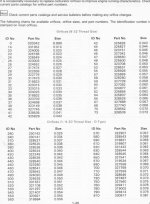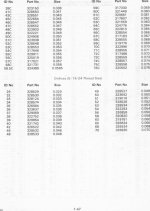I am trying to set idle timing at 5 deg. No plugs in at cranking speed..... The idle set screw is screwed all the way in and I am only reading 4 degrees..... (was at 2 degrees) Going to continue the process and go to lake with a helper to measure WOT timing.
Does my idle screw issue mean a timer base adjustment may be needed???/QUOTE]
No... I mentioned the idle stop screw simply to use as a lock to keep the linkage from moving. Back that screw out and later set the idle rpms to 1000 on a flushette, then set the idle screw so that the rpm will not drop under that 1000 rpm reading at idle/neutral.
You can set the idle timing simply by moving the throttle cable wherever it needs to be... a setting of anywhere between 4 to 6 degrees actually.... then after you have that setting, if the scribe mark on the cam is not aligned/touching with the center of the roller, adjust the nylon yoke so that it is.
You can adjust the full spark advance at cranking speed if you desire to as follows:
NOTE: If your engine has the "Fast Start" feature", you must disconnect/eliminate that feature in order to use the following method. The "Fast Start" automatically advances the spark electronically when the engine first starts, dropping it to normal when the engine reaches a certain temperature.
The full spark advance can be adjusted at cranking speed,"without" have the engine running as follows.
To set the timing on that engine, have the s/plugs out, and have the throttle at full, set that timer base under the flywheel tight against the rubber stop on the end of the full spark timer advance stop screw (wire it against that stop if necessary).
Rig up a spark tester on the #1 cylinder plug wire. Hook up the timing light to the #1 plug wire. Crank the engine over and set the spark advance to 4° less than what the engine calls for.
It's a good idea to ground the other plug wires to avoid sparks that could ignite fuel that may shoot out of the plug holes. I've personally never grounded them out and have never encountered a problem but it could happen.
I don't know the full spark advance setting your engine calls for, but to pick a figure, say your engine calls for 28°, set the timing at 24°. The reasoning for the 4° difference is that when the engine is actually running, due to the nature of the solid state ignition components, the engine gains the extra 4°.
If you set the engine to its true setting at cranking speed, when running it will advance beyond its limit by 4° which will set up pre-ignition causing guaranteed piston damage! You don't want that to take place.
No need to be concerned about the idle timing as that will take care of itself. The main concern is the full advance setting.
A fellow member from one of the various marine forums suggested having water supplied to the water pump (flushette or barrel) simply to provide lubrication to impeller. A worthwhile suggestion I thought, and entered here.
Be sure to use your own engines spark advance settings, not the one I picked out of the air here in my notes.
Thousands of parts in my remaining stock. Not able to list them all. Let me know what you need and I'll look it up for you. Visit my eBay auction at:
http://shop.ebay.com/Joe_OMC32/m.html?_dmd=1&_ipg=50&_sop=12&_rdc=1
********************



